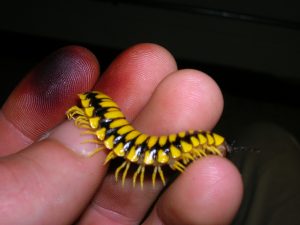Grant enables biologist to study spiders, millipedes
Grant enables biologist to study spiders, millipedes

The photos from this site are available for public use. Use “ECU News Bureau” for photo credit unless noted otherwise. To download a photo, click on the image and save to your computer.
Contact: mcgillicuddyn@.ecu.edu
Millipedes, like this one, are being studied by ECU biologist Jason Bond. (Contributed photo)
An ECU biologist has received three grants from the National Science Foundation to study millipedes and spiders.
Jason Bond, professor of biology at ECU, is documenting, studying and cataloging species from around the world in an effort to further what is known about these diverse, yet understudied, arthropod groups.
The first grant, called Partnership for Enhancing Expertise in Taxonomy (PEET), shared with Dr. Petra Sierwald at the Field Museum of Natural History in Chicago will enable Bond to enlist graduate and undergraduate students to research and update what is known about millipedes.
Millipedes, commonly referred to as thousand-leggers, are in fact leggy (not quite a thousand legs), long cylindrical creatures with a hardened protective exoskeleton. Bond said that only a fraction of an estimated 80,000 species of millipede are known and catalogued.
millipede
The research grant for $750,000 formally begin Jan. 1, 2006.
“At its most basic level I am training students to classify and describe new species of millipedes,” Bond said of the PEET grant. “We always start by examining specimens from museum collections and then go out into the field to collect more.”
Students from Bond’s lab spend time in the collections at the Smithsonian, American Museum of Natural History, and the Field Museum of Natural History and do field work all over the world.
Bond has also received a second grant from the NSF, called Revisionary Syntheses in Systematics, in 2003. It has enabled him to study species of trapdoor spiders and contribute to the National Science Foundation’s Tree of Life project, which will eventually name and categorize 1.7 million animal species. Bond said he had identified 30 to 40 new species of the trapdoor spider during this time. Last year Bond and his students described new species of trapdoor spiders from California, North Carolina, and South Africa.
Bond collaborates with colleagues from around the country and world and serves as a co-investigator with scientists at museums of natural history in Chicago, Washington D.C., and New York. The biodiversity aspect of both projects is important, said Bond, because it equips scientists with information that will help them to better understand biodiversity and strategies for its preservation. In some cases, areas that had once been on record as a habitat for a millipede or spider species are now developed parcels of land.
“We’re just trying to document what is here now. There are species in museum collections that no longer exist in nature. There is a general attitude,